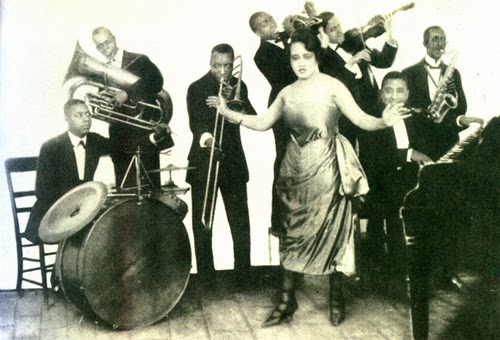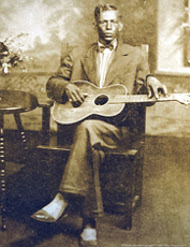The first recorded blues turns 100. So what else happened in 1914?
“Mainla shit war … better the world would have been listened to the paulmerryblues!!! Music does not harm anybody! Sergeant Six (@sergeantsix), Munich, Germany. January 8, 2014.
BLUESMUSE49. Start
spreading the news. The world’s first blues recording, The Memphis Blues, was
laid down three times in New York 100 years ago this coming July. But as I’ve
written enough about Memphis Blues’ centenary (see 11 December 2013 post), how
about finding out what other interesting musical events happened exactly 100
years ago?
second calypso ever recorded and the first recorded in the West Indies, which
made its debut in 1914.
recorded, however, actually came along in 1912, which was a good two years
 |
| Trinidad’s Lovey’s String Band |
before
the first recorded blues. Like the first blues, the first calypso, called Mango
Vert, was recorded in New York. Here’s a YouTube link:
the first calypso was cut in 1912 by Lovey’s String Band, who hailed from
calypso’s birthplace, Trinidad. Active from the 1890s to the 1920s, other songs
in the Lovey’s (sound like British actors, don’t they?) catalogue included a
smoking version of a number called Mari-Juana. And, as an example of the
infancy of
 |
| Ballin’ the Jack sheet music |
the recording industry, by 1914 the release of blues records had
outstripped the calypso records released: by three to two.
released in 1914 were few and far between, one of the most popular was a disc called
Ballin’ The Jack by Prince’s Orchestra. Ballin’ The Jack was an American dance
craze of the era, as you’ll see from its lyrics below.
the right,
might,
performers who have since recorded
 |
| Little Miss Dynamite, Brenda Lee |
Ballin’ The Jack, this Brenda Lee version
from 1960 is my favourite:
(to me, anyway), when I arrived in Australia from England in 1973, a great Aussie
band called Daddy Cool was all the rage down under and one of their tracks was
Eagle Rock. Little did anyone know Eagle Rock was first mentioned on record in
1914, except Daddy Cool, of course. For those interested in hearing a top song,
here’s the link:
record label in Oz and remembered the band being promoted in London as an
American band, would you believe. Their
 |
| Daddy Who? Daddy Cool: worth a listen |
management didn’t want anyone to know
they were Aussies. Daddy Cool also had quite a bit of exposure in the USA at
the time, I believe. Anyone remember them?
by the comic duo, Arthur Collins and
Byron G. Harlan. If you don’t know the song, you probably know the chorus:
“Aba daba daba daba daba daba dab, Said the chimpie to the monk; Baba daba daba
daba daba daba dab, Said the monkey to the chimp.” Collins & Harlan’s 1916
song, That Funny Jas Band
from Dixieland, incidentally, featured one of the first recorded uses of the
word “Jas,” which eventually became known as jazz.
year in the USA in 1914 was a record called The Little Ford Rambled Right Along
by Billy Murray. Listening to this novelty song about the new Model T Ford, I
can hear Murray’s vocal influences on the English comic songster, George Formby.
If you’re a bit of a motor head, why not take a listen:
of the many songs published in 1914 (as opposed to being recorded) were two
W.C. Handy compositions: St. Louis Blues and The Yellow Dog Blues. 1914 was
also the year,
the Georgia
 |
| Lucille Hegamin and her band in Chicago c. 1914 |
Peach, Lucille Hegamin, moved to Chicago where she worked with
pianists Tony Jackson and Jelly Roll Morton, before marrying another pianist,
Billy Hegamin. Lucille Hegamin once said: “I think I can say without bragging
that I made the St. Louis Blues popular in Chicago”.
and Will Rainey (Ma and Pa) started touring America as Rainey and Rainey,
Assassinators of the Blues; while the biggest song on the South’s black vaudeville circuit was still Baby Seal’s Blues. This song had the
distinction of being the second blues ever published (in August 1912), the
first blues published with vocals, and the first blues published that was written
by an African American. Tellingly, the sheet music instructed the
musicians to play the tune very slowly, just as Hart Wand’s Dallas Blues sheet
music had six months’ earlier in March 1912.
 |
| Sonny Boy 1: born in 1914 |
original Sonny Boy Williamson was born John Lee Williamson near Jackson,
Tennessee, in 1914. The original Sonny Boy Williamson’s blues harmonica-playing
set the standard for the traditional Chicago blues harp sound for generations
to come.
everything in 1914, of course, was the outbreak of World War One and a host of
tunes now associated with that war were published that year including, It’s a
Long, Long Way To Tipperary. A British music hall song by Jack Judge that topped
America’s Billboard chart for 13 weeks, It’s a Long, Long Way To Tipperary was recorded
by the American Quartet with Billy Murray, who seems to have been having a good
year in 1914.
a Long, Long Way To Tipperary has since lost one of its “longs” and is now referred
to simply It’s a Long Way To Tipperary.
more on the history of the blues, packed with hundreds of photographs, why not
check How Blues Evolved now at Amazon. Even better, why not buy it. It’s going
for a song.

 In the UK, preview How Blues Evolved on this link below:
In the UK, preview How Blues Evolved on this link below:http://www.amazon.co.uk/s/ref=nb_sb_noss?url=search-alias%3Ddigital-text&field-keywords=how+blues+evolved+volume+one





